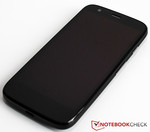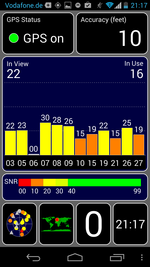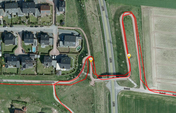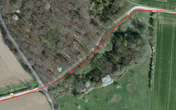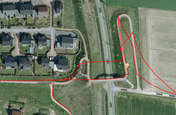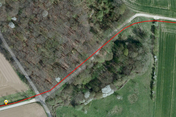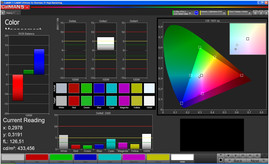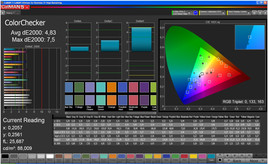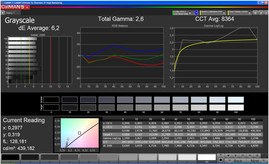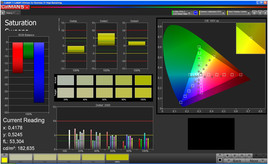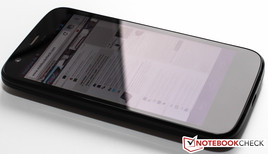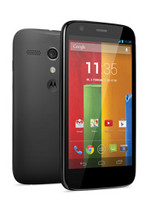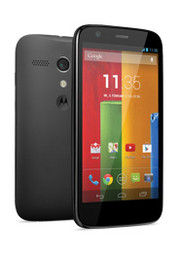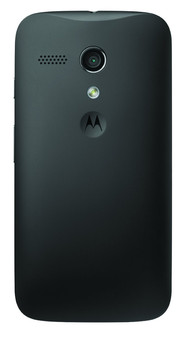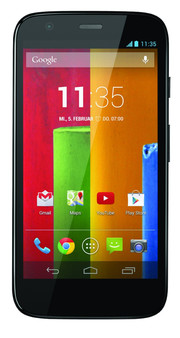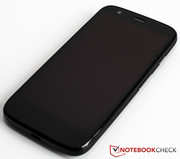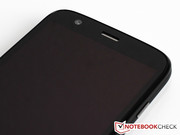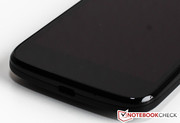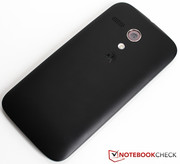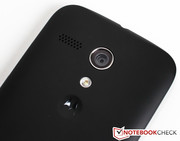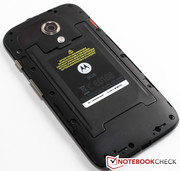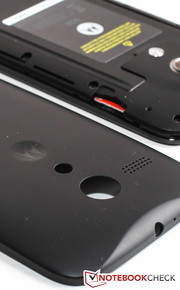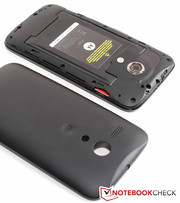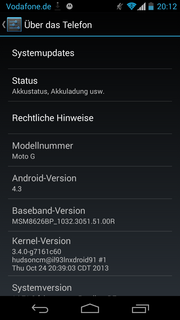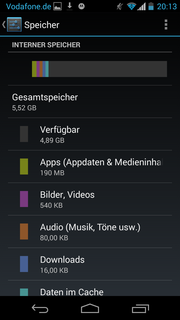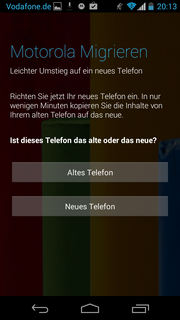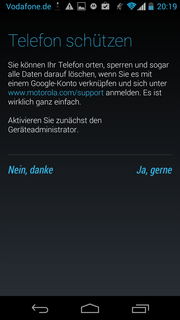Review Motorola Moto G Smartphone

For the original German review, see here.
The omnipresent manufacturer Google is presently experiencing a run with devices from its Nexus product line. The purchase price is more than fair compared with the models competing against the Nexus 5. The Moto G is Motorola's first mid-range model on the market that lures with a very attractive price, and puts other manufacturers in a tight situation. The 8 GB model is available for 169 Euros (~$229), and the 16 GB version costs 199 Euros (~$270). The price includes a 4.5-inch screen alongside a Snapdragon 400 quad-core with 1.2 GHz, embedded in a non-slip polycarbonate casing. If the hardware and software combination deliver what they promise, Google might very possibly have launched another top-seller on the market.
Case
The casing of the Moto G is all over plastic. Although the battery can only be exchanged by an expert, the back cover can be removed. This is possible for two reasons: The micro-SIM card is inserted under the cover, and there are several colors available for the interchangeable back.
The smartphone certainly cannot be called thin with dimensions of 129.9 x 65.9 x 11.6 mm. This is an advantage for the casing's stiffness, but a disadvantage for carrying it in a pocket. That is still 2.5 mm thicker and 4 grams heavier than the Nexus 4 model. The mid-range model features a precise and solid build. The smartphone easily defied our warping attempts, and is also resistant against selective pressure.
Connectivity
The USB port is on the device's lower edge. As usual, it can be used for either recharging the phone, or connecting it to a computer. No interfaces are found on the left. Both the volume rocker and power button are installed on the right. A 3.5 mm jack for external players is on the upper edge.
The back cover is interchangeable, but the battery should only be replaced by an expert. Also, the internal storage cannot be expanded via an SD card. Thus, the buyer should carefully consider whether the 8 GB or the 16 GB version makes more sense.
Software
Since Motorola is associated with the Google Group, the Moto G's system should principally be updated in a timely manner. Android version 4.3 is now installed, but Google holds out the prospect that KitKat will be launched in early 2014. As is known from the Nexus line devices, Android is installed in an untainted, original state. No frills or other trouble-making apps paralyze the system.
Communication & GPS
A few cutbacks have to be accepted in view of the purchase price. One is found in the Wi-Fi module's standards. It transmits in 802.11 b/g/n and does not support dual-channel mode. Nevertheless, both the transmission and reception speeds are high enough to perform all functions with the known conditions. A stable connection to other peripherals is also possible via Bluetooth.
Of course, a GPS module should be installed, and it also supports GLONASS. Connecting to corresponding satellites is accomplished quickly, and is fairly accurate even indoors. The Garmin Edge 500 clearly defeated the Moto G in our test. The smartphone missed about 400 meters in sum. We particularly overtaxed the Moto G on a road section with a tight curve, but it exhibited a fairly high accuracy in the woods.
Telephony and Speech Quality
We experienced a loud and clear reproduction in our numerous test calls. The Moto G also has a good volume so that making calls even in slightly louder environments is possible. Since there is no in-ear headset included, only the hands-free feature is available when the user is busy. It is naturally possible to connect an optional in-ear headset to the phone.
Cameras and Multimedia
The low-priced smartphone features a total of two camera modules. A 1.3 MP sensor is on the front, and a 5 MP camera is installed on the rear. The rear-facing unit can of course record videos in HD quality. This is performed with up to 30 frames per second in MPEG4 format.
Compared with pictures from competing models, the 5 MP camera in the Moto G performs well. We, however, adversely noticed that dark areas lack depth. Also, the screenshot "Surroundings" exhibits intense vignetting in the image's upper corner. In terms of sharpness, the camera does the best it can, but no miracles should be expected from a 5 MP module. Nevertheless, the result is quite usable.
Accessories and Warranty
An abundant scope of accessories cannot be expected considering the (8GB) review sample's competitive price of 169 Euros (~$229). Besides the modular power supply, there are various printed instructions, and warranty conditions in the box. The "Motorola Shell" is optionally available in different colors to customize the Moto G. They cost between 15 and 20 Euros (~$20 and ~$27) depending on the color. Besides that, there is also a version with a flip-cover screen protector - also in many colors.
Like for all Google devices, the manufacturer only includes a 12 month warranty. The battery is only covered for 6 months.
Input Devices and Controls
A capacitive screen that supports multi-touch gestures is installed in the Moto G. It can be used with up to 5 fingers. The inputs are implemented immediately and accurately. There is barely a sign of delay. Of course, the performance is not on par with premium devices, but all tasks were processed reliably, and in an acceptable speed. Owing to Google's spartan keyboard, the input covers less than 50% of the screen in both landscape and portrait mode.
Display
With 4.5-inches, the Moto G is almost as big as the former premium model from the parent company Google. The screen features a resolution of 1280x768 pixels. Naturally, considerably higher resolutions are now possible. However, how much sense they make in such small screens is still debatable. Besides that, high-end components cannot be expected for a purchase price of 169 or 199 Euros (~$229 or ~$270).
Nevertheless, the Moto G holds its own on the test bench. The screen is very bright with an average brightness of 416.6 cd/m², and achieves a much better result than the Nexus 4 (275.3 cd/m²). The homogeneity is also given with 89%. The only thing standing in the way of a contrast over 1000:1 is the slightly increased black level of 0.54 cd/m², and the Moto G just surpasses 800:1.
| |||||||||||||||||||||||||
Brightness Distribution: 89 %
Center on Battery: 441 cd/m²
Contrast: 817:1 (Black: 0.54 cd/m²)
ΔE ColorChecker Calman: 4.83 | ∀{0.5-29.43 Ø4.78}
ΔE Greyscale Calman: 6.2 | ∀{0.09-98 Ø5}
Gamma: 2.6
CCT: 8364 K
The Moto G's screen has problems reproducing red, which results in a pale color reproduction. We observed the opposite in blue hues. The DeltaE 2000 rate delivered an acceptable rate of 4.83 on average - of course, seen in relation to price. The color temperature result was a bit poorer because the grayscale does not correspond to any natural colors with 8364 K. Larger shifts in light gray hues were particularly noticed in the grayscale gradient.
A modern smartphone = a state-of-the-art screen with high viewing angle stability. Nowadays, we barely test devices where the quality of the displayed content is dependent on the specific viewing angle. The manufacturers largely provide high-quality results with this component. However, there are minor differences here. Everything worked to our satisfaction in the Moto G - a good score in the viewing angle test.
Generally, all review samples do a good job in outdoor use in the winter season because the devices do not have to struggle as much with reflections for the lack of sunlight. However, the Moto G has a high brightness, which is essential for the smartphone's good result. Users who want to reduce the reflections should consider buying a matte screen protector.
Motorola's mid-range model sports a Snapdragon 400 from Qualcomm. It is built in the 28 nm process, and follows the ARMv7 instruction set. The SoC features four cores, and each clocks with 1.2 GHz (ARM Cortex A7). A quad-core also works in the bigger Snapdragon 400, but a Krait 400 CPU with a higher clock rate is used. In addition to the Adreno 305 GPU, 1 GB working memory is installed.
We added Google's flagship to the comparison list as a reference. Of course, the Moto G only has a slight chance against the premium model, but it is remarkable how close the results of both smartphones sometimes are, regarded as a touchstone. Samsung's Galaxy Ace 3 and our review sample frequently swap places, which is a sign that their performance is on a similar level. The scores of the Nexus 5 and Moto G are quite similar in both the older NenaMark2 and Linpack for Android benchmarks. We can confirm these scores subjectively because barely any performance differences turn up in reading emails or Internet browsing routine.
| GFXBench (DX / GLBenchmark) 2.7 | |
| T-Rex Onscreen (sort by value) | |
| Motorola Moto G 1. Gen XT1032 | |
| Google Nexus 4 | |
| Google Nexus 5 | |
| Samsung Galaxy S4 Mini GT-I9195 | |
| Samsung Galaxy Ace 3 GT-S7275R | |
| 1920x1080 T-Rex Offscreen (sort by value) | |
| Motorola Moto G 1. Gen XT1032 | |
| Google Nexus 4 | |
| Google Nexus 5 | |
| Samsung Galaxy S4 Mini GT-I9195 | |
| Samsung Galaxy Ace 3 GT-S7275R | |
| NenaMark2 - --- (sort by value) | |
| Motorola Moto G 1. Gen XT1032 | |
| Google Nexus 4 | |
| Google Nexus 5 | |
| Samsung Galaxy S4 Mini GT-I9195 | |
| Samsung Galaxy Ace 3 GT-S7275R | |
| Geekbench 3 | |
| 32 Bit Multi-Core Score (sort by value) | |
| Motorola Moto G 1. Gen XT1032 | |
| Google Nexus 4 | |
| Google Nexus 5 | |
| Samsung Galaxy Ace 3 GT-S7275R | |
| 32 Bit Single-Core Score (sort by value) | |
| Motorola Moto G 1. Gen XT1032 | |
| Google Nexus 4 | |
| Google Nexus 5 | |
| Samsung Galaxy Ace 3 GT-S7275R | |
The Moto G did surprisingly well in Browsermark 2.0. Except for the iPhone 5c and Google's Nexus 5, the low-priced smartphone surpasses all contenders. The score is put back into perspective a bit in the following browser-based benchmarks. Nevertheless, the review sample shows itself from its best side.
| Browsermark - --- (sort by value) | |
| Motorola Moto G 1. Gen XT1032 | |
| Google Nexus 4 | |
| Google Nexus 5 | |
| Samsung Galaxy S4 Mini GT-I9195 | |
| Nokia Lumia 625 | |
| Apple iPhone 5c | |
| Samsung Galaxy Ace 3 GT-S7275R | |
| Peacekeeper - --- (sort by value) | |
| Motorola Moto G 1. Gen XT1032 | |
| Google Nexus 4 | |
| Google Nexus 5 | |
| Samsung Galaxy S4 Mini GT-I9195 | |
| Nokia Lumia 625 | |
| Apple iPhone 5c | |
| Samsung Galaxy Ace 3 GT-S7275R | |
| Octane V1 - Total Score (sort by value) | |
| Motorola Moto G 1. Gen XT1032 | |
| Google Nexus 4 | |
| Google Nexus 5 | |
| Samsung Galaxy S4 Mini GT-I9195 | |
| Nokia Lumia 625 | |
| Apple iPhone 5c | |
| Samsung Galaxy Ace 3 GT-S7275R | |
| Mozilla Kraken 1.0 - Total (sort by value) | |
| Motorola Moto G 1. Gen XT1032 | |
| Google Nexus 4 | |
| Google Nexus 5 | |
| Samsung Galaxy S4 Mini GT-I9195 | |
* ... smaller is better
Always good for a surprise, we thought in the first comparison of the ascertained read and write access speeds. The smartphone won almost every test, and some with a big lead. Motorola sets extremely high standards, and also shows the competition how much power is possible on a low budget.
Games and Videos
The preceding test sections clearly proved that the Moto G and its Snapdragon 400 do not at all have to hide from performance-intensive applications. We rechecked whether loading delays or lags evolve based on various 2D and 3D games. No matter if it was Modern Combat 4: Zero Hour, GTA ViceCity or the less demanding Angry Birds - no title could push the smartphone to the verge of its performance limits.
We also made a similar observation with Full HD video playback. All sequences could be played impeccably using the installed player. There were only problems with playing QFHD videos (Ultra-HD), but Qualcomm does not claim that the Snapdragon 400 can do that anyway. The difference to the larger and more expensive Snapdragon 800 becomes evident here.
Emissions
Temperature
We naturally ascertained the maximum temperature during full load. It was an average of 32.5 °C on the front, and only 29.8 °C on the back. The contenders do not come remotely close to that. With 34.9 °C, the Galaxy Ace 3 is noticeably warmer, and the Nexus 4's temperatures are even higher with rates ranging from 36.8 °C to 37.8 °C. The Moto G's temperatures drop even further in idle. We measured not more than 27 °C - 28 °C on its surfaces. The Galaxy Ace 3 comes close to these rates, but the Nexus 4 does not drop below 30 °C. Very good performance alongside low temperatures - what else could the user want?
(+) The maximum temperature on the upper side is 34.6 °C / 94 F, compared to the average of 35.2 °C / 95 F, ranging from 21.9 to 247 °C for the class Smartphone.
(+) The bottom heats up to a maximum of 31.2 °C / 88 F, compared to the average of 34 °C / 93 F
(+) In idle usage, the average temperature for the upper side is 28 °C / 82 F, compared to the device average of 32.9 °C / 91 F.
Speakers
The small speaker on the back makes a great deal of noise - and the sound is fairly good up to 90% of the maximum volume. Low pitches are non-existent, but the sound barely distorts. This is basically in line with the Moto G's overall impression. Miracles cannot be expected for this purchase price, but surprises always happen.
Energy Management
Power Consumption
A power requirement ranging from 0.4 - 2.8 watts is needed to work with the Moto G. This is split as follows: When mainly undemanding tasks are performed, the hardware consumes between 0.4 and 1.0 watts. The Nexus 4 is not quite as frugal as that with rates from 0.7 to 1.4 watts. This becomes even clearer during full load because the Nexus 4 needs 3.9 - 6.5 watts, and the Moto G only consumes 2.1 to 2.8 watts. The performance difference of both devices is not that extreme as was seen earlier in this test report. However, the Nexus 4 has a slightly larger screen - which is certainly a reason for its somewhat higher power consumption.
| Off / Standby | |
| Idle | |
| Load |
|
Key:
min: | |
Battery Runtime
The outcome of this part is certainly very dependent on power consumption. However, the battery's capacity also plays a role. The Moto G's battery has 2070 mAh, and is almost just as strong as the one in the Nexus 4 (2100 mAh). The smartphone achieved a full load runtime of just over 4 hours. The extremely long-running LG G2 cannot compete with that (3:40 h). The affordable phone lasted for an outstanding 25 hours and 15 minutes with dimmed screen brightness and idle SoC. LG's G2 only presents a slightly better runtime in the Wi-Fi test. Nevertheless, the Moto G's endurance is more than satisfactory with 15 hours and 30 minutes.
Verdict
Google led the way with its Nexus 4, and to-date with the Nexus 5. It now applies this strategy to the bought out manufacturer Motorola - high-performance hardware alongside appealing looks, and a good build at an affordable price. The Moto G is currently priced at 169 Euros (~$229) for the 8 GB version, and 199 Euros (~$270) is charged for twice the storage. This competitive price also puts the manufacturers in the mid-range segment under high pressure - and with good reason since the Moto G convinced us in our test. The Snapdragon 400 does a fantastic job, and does not need to hide from high-end models. That is paired with a long battery runtime and a very bright screen. Motorola does the stylish aspect justice with the interchangeable back covers in various colors, and thus arranges a bit of individuality in the Moto G's concept.
Buyers looking for a medium-sized smartphone (4.5-inches) that sports high-performance hardware for little money will hardly pass by Motorola's Moto G - let the price fight in the mid-range sector begin.




